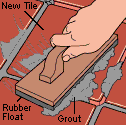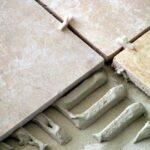This expert how-to explains how fix grout problems, from cleaning stained tile and grout to a step-by-step walkthrough of the re-grouting process.
There is no way to completely prevent grout stains, but you can minimize visible stains by selecting natural grout colors because they offer better hiding. Applying a grout sealer helps protect grout from staining; grout should be re-sealed after a thorough cleaning every two or three years.
Stains in grout can often be cleaned or, in the case of white grout, bleached. When cleaning grout doesn’t solve the problem, replacing grout may become necessary. If re-grouting looks like a job you would rather leave to a professional, ask a local tile supplier for recommendations.
Cleaning Grout
To clean tile grout on ceramic tile, buy a pH-neutral tile-cleaning solution from a tile store. Wearing rubber gloves, mix it according to the label’s directions. Unless your grout is white, do not use a cleanser that contains bleach because it may lighten the grout’s color. For colored grout, test your cleanser first in an inconspicuous place.
Pour it onto the tile surface and brush it onto vertical surfaces using a relatively soft-bristle scrub brush.
Using the brush, thoroughly scrub all grout lines and surfaces. Then use a sponge to rinse the surface with clear water to remove the solution. Once it becomes wet, grout darkens, hiding stains, so mop or sop up the wetness with a rag and allow the grout to dry. Repeat scrubbing with the cleaning solution if necessary. For really tough stains, consult your local tile dealer for a stronger cleanser.
Cleaning Stained Tile & Grout
Stains on tile can often be scrubbed out with a white cleansing powder and a nylon scrubbing pad or a stiff scrub brush. For particularly stubborn stains, you can buy commercial tile cleaners; be sure to follow the label directions exactly. Never mix a tile cleaner that contains ammonia or acid with chlorine bleach as this mixture releases the chlorine as a poisonous gas.
The grout used to fill the voids between individual tiles often becomes dingy and stained. At a tile store, you can purchase a pH-neutral tile-cleaning solution. Unless your grout is white white, do not use a cleanser that contains bleach because it could lighten your grout’s color. Mix it according to label directions (wear rubber gloves). Permanently stained grout will have to be replaced.
1 Pour the cleaner onto the floor and scrub it into the grout lines with a soft-bristle brush.
2 Using a sponge and clear water, rinse the surface completely. With a rag, sop up the water so the grout will dry quickly-damp dark grout will hide stains.
3 To remove stains that won’t come out when you use the following methods, consult your tile dealer about a stronger cleanser.
- Coffee, wine, mustard, fruit juice: Scrub with a non-bleaching cleaner. Allow it to sit for several minutes and then rinse.
- Hard water, rust: Scrub with a non-bleaching scouring powder and then rinse thoroughly.
- Fresh paint: Remove with commercial paint remover, per label directions.
- Oil: Scrub with detergent or with a mixture of 10 percent sodium carbonate in water.
- Old paint: Carefully loosen the paint with a razor blade. If necessary, follow up with paint remover.
Re-grouting Tile
If your tile’s grout is beyond cleaning, it may be necessary to scrape it out and replace it with new grout. You might be able to do this in a limited area, but it can be very difficult to get the color and tone of new grout to match older grout-so you may have to re-grout the entire area. Depending upon how much grout you have, this can be a big job. For more about this, please see How to Grout Tile.
1 Use a grout saw to cut away any cracked or loose grout and to score stable grout between tiles. Clean away dirt and debris with a soft-bristle brush.
2 Wearing latex gloves, mix up the new matching grout according to label directions.
3 Hold the leading edge of a rubber grout float up at a slight angle and apply grout along the tile, working it deep into the crevices. Then use your finger to smooth the grout.
4 Allow the grout to set up slightly. With a damp sponge, wipe off the excess from the surface of the tile. Allow the grout to completely set up for several days and then apply grout sealer with a sponge brush.








 Don Vandervort writes or edits every article at HomeTips. Don has:
Don Vandervort writes or edits every article at HomeTips. Don has:




